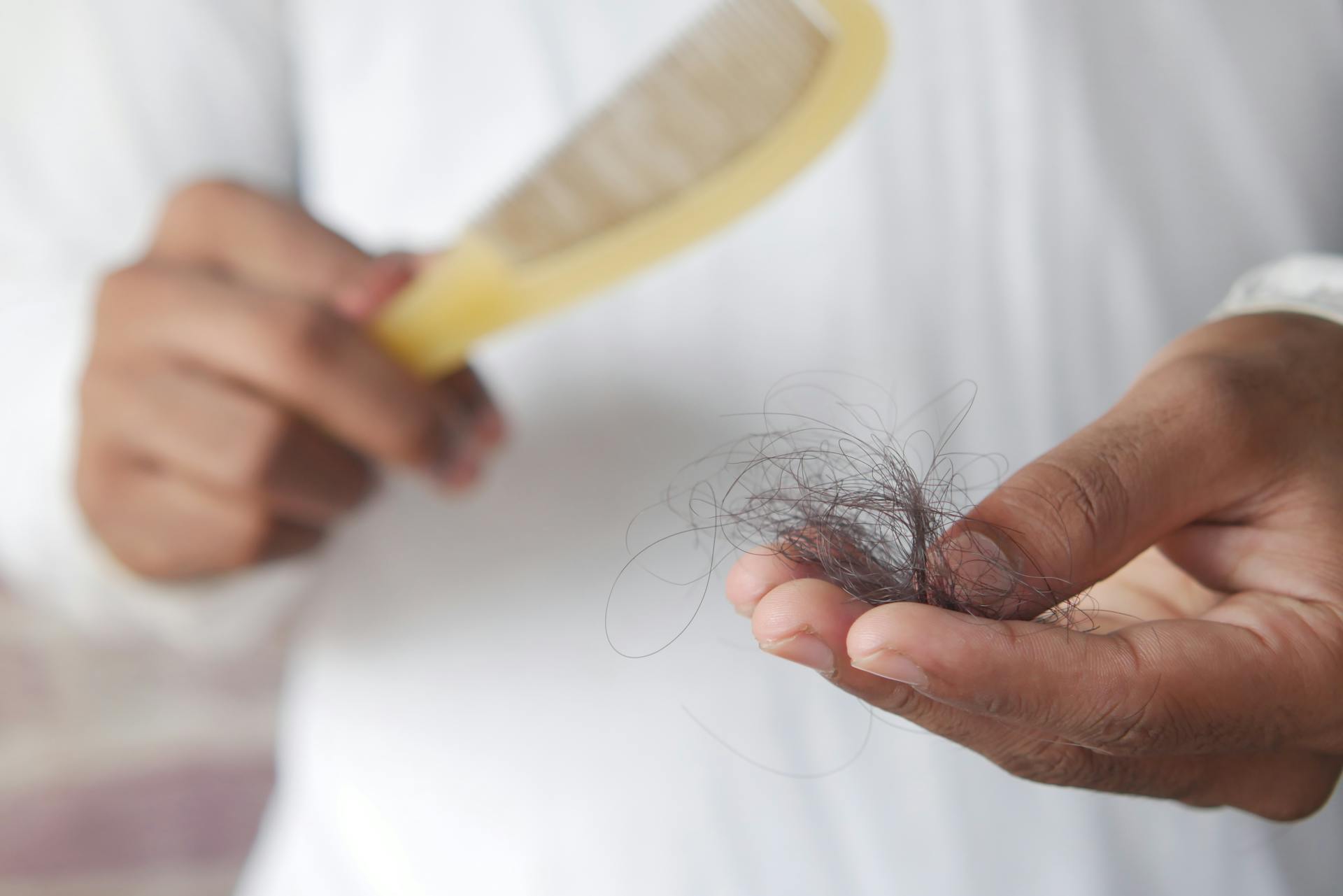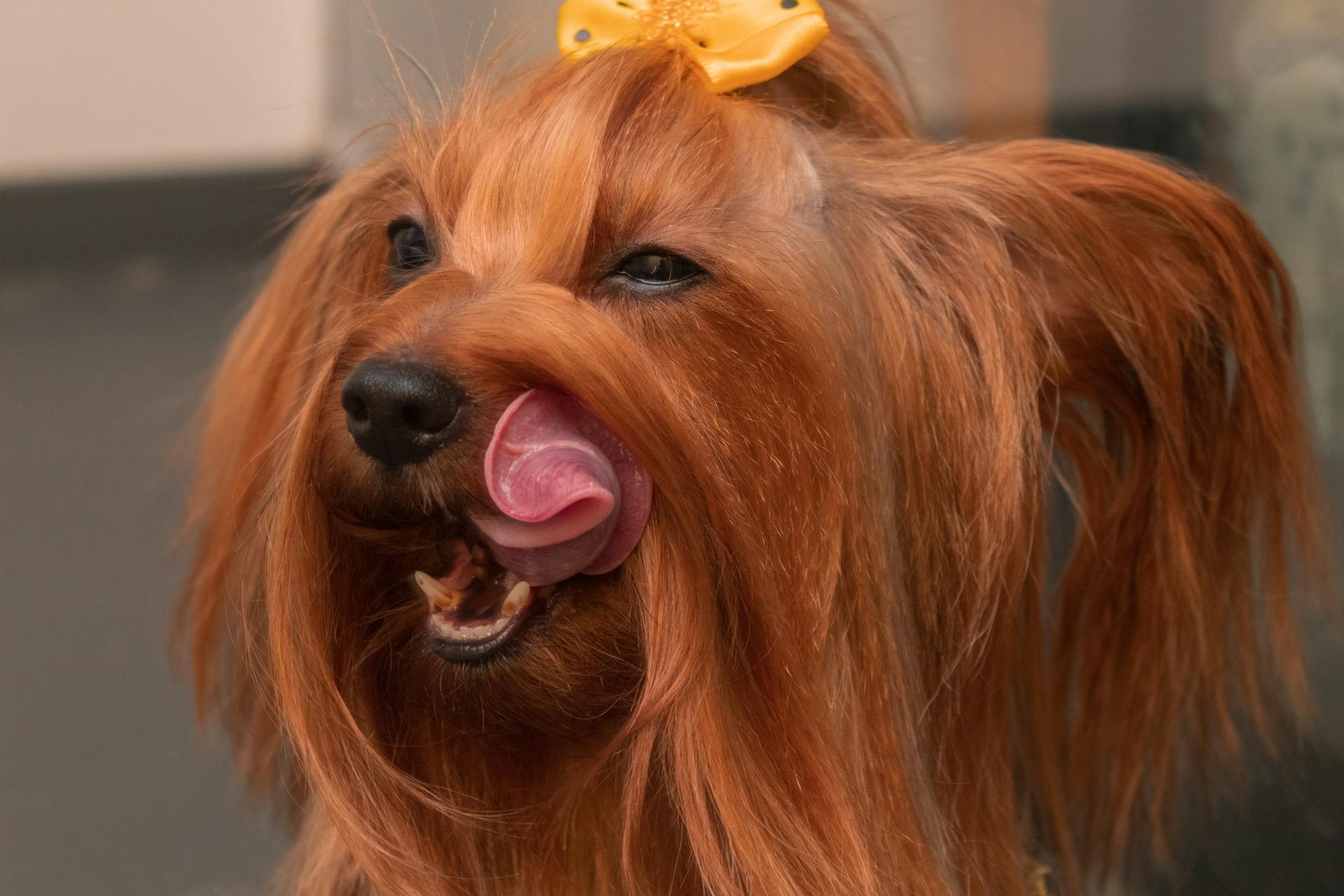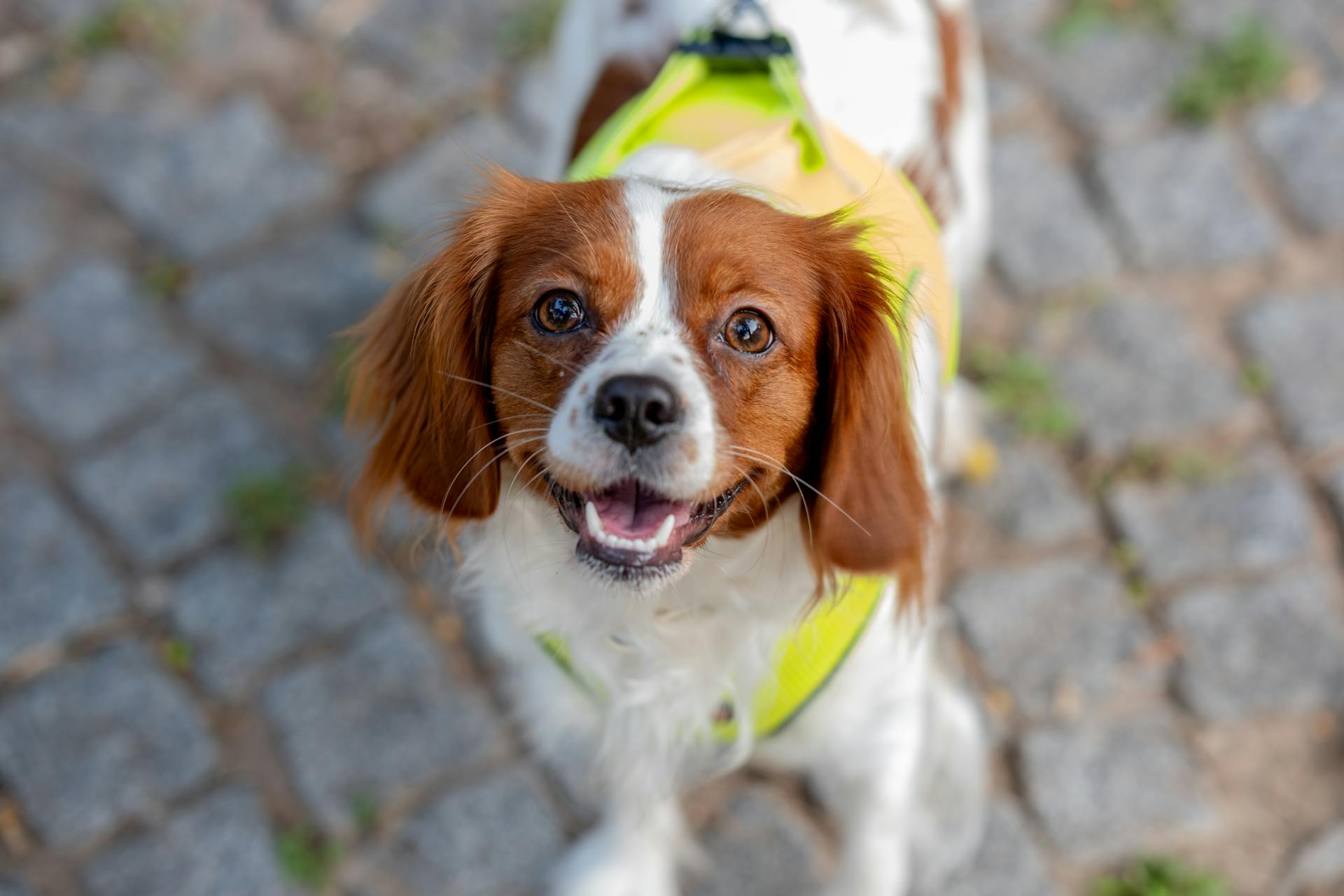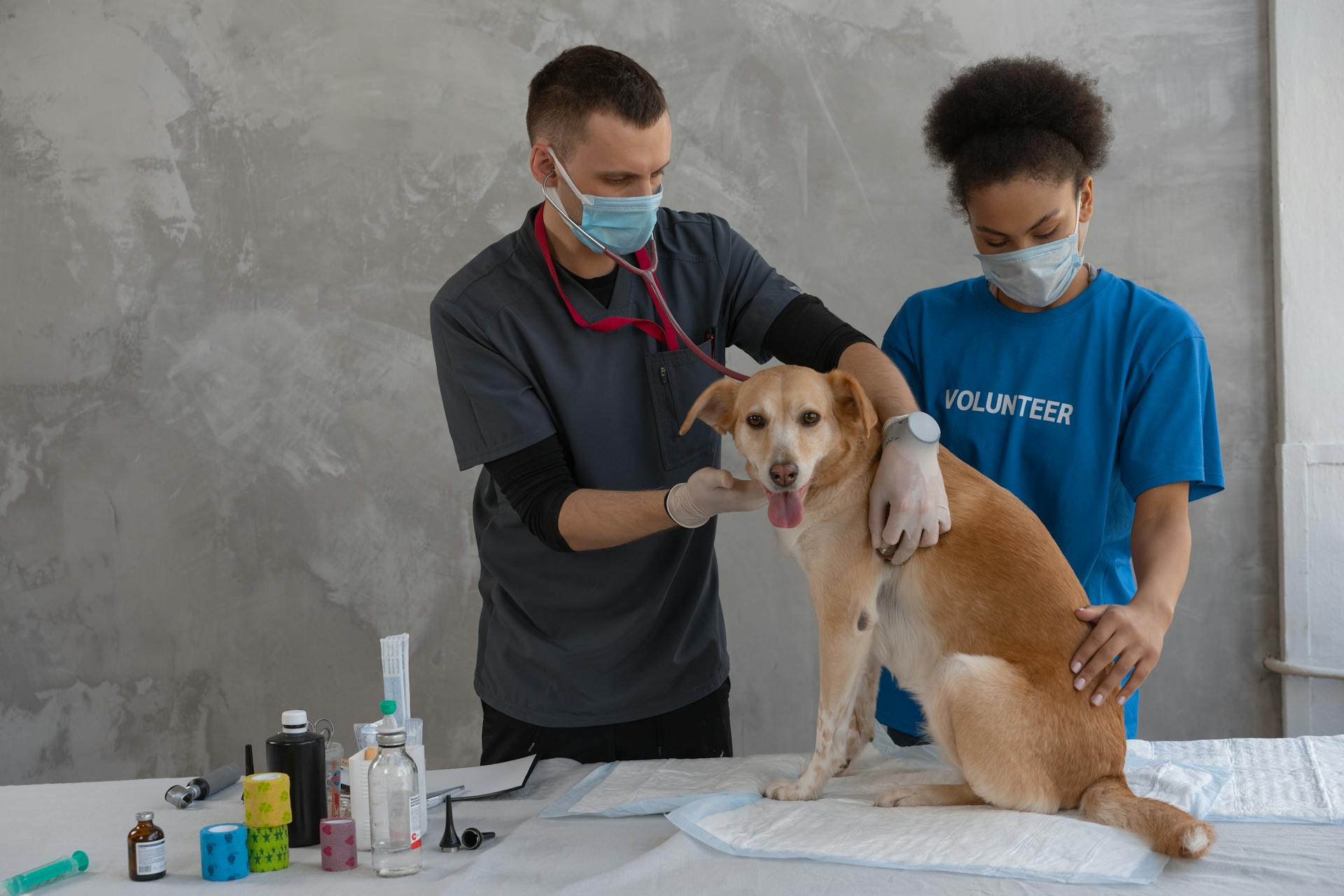
Dogs can suffer from various diseases that cause hair loss, and it's essential to understand the underlying causes to provide the best care for your furry friend.
Some common dog diseases that cause hair loss include Cushing's disease, which affects the adrenal gland and can lead to excessive shedding.
Dogs with Cushing's disease may also experience weight gain, increased thirst and urination, and thinning of the skin.
As a responsible dog owner, recognizing the signs of these diseases can help you seek veterinary care early on, reducing the risk of complications and ensuring your dog receives the necessary treatment.
Causes of Dog Hair Loss
Dog hair loss can be caused by a variety of factors, ranging from genetic conditions to environmental triggers.
Some breeds are more prone to congenital hair loss due to genetic factors. For example, dogs with dilute coat colors may possess a recessive gene that affects the structure and function of their hair follicles, leading to hair loss and skin problems.
Trauma, such as burns or repeated scratching or chewing, can also disrupt hair growth and lead to hair loss. This can be especially true for dogs with excessive grooming habits.
Infections, including bacterial or fungal infections, can damage the hair shaft and cause hair loss. Skin scrapings and impression smears can help diagnose these types of infections.
Autoimmune diseases, such as Cushing's or hypothyroidism, can also cause hair loss. These conditions affect the endocrine system and can lead to a range of symptoms, including hair loss.
Other potential causes of hair loss include parasites, such as fleas, and allergic reactions to food or environmental substances. A comprehensive parasite control program and diagnostic tests for allergic skin disease can help identify and address these issues.
Here are some common patterns associated with canine alopecia:
- All over thinning in a certain area, such as the belly, sides, ears, or top of the head or back
- Circular bald patches that can occur anywhere on the body
- Hair loss with skin problems, such as red, flaky, or crusted skin
- Other symptoms, such as lethargy or loss of interest in favorite activities
These patterns can help identify potential causes of hair loss and guide further diagnosis and treatment.
Symptoms and Diagnosis
Dog hair loss can be a symptom of an underlying issue, so it's essential to recognize the signs and seek veterinary assistance.
Hair loss in dogs can be caused by various factors, including genetics, allergies, and infections. The symptoms may be obvious, but they can also be subtle, depending on the disease.
Some common symptoms of dog hair loss include dandruff, itchy skin, patches of dark skin, brittle or dry coat, and excessive shedding. If you notice any of these symptoms, it's crucial to take your dog to the vet for a proper diagnosis.
Here are some common signs of dog hair loss:
- Dandruff
- Itchy skin
- Patches of dark skin
- Brittle or dry coat
- Excessive shedding
- Crusting or red patches around the bald patches
- Inflammation around bald patches
A veterinarian will typically perform a physical examination, skin scrapings for parasites, blood tests, and skin cultures or biopsies to diagnose alopecia in dogs. They will also check for any underlying causes, such as skin infections or allergies.
Symptoms
Symptoms of hair loss in dogs can be quite obvious, but there are other signs to look out for beyond the missing hair.
Hair loss might be accompanied by dandruff, itchy skin, patches of dark skin, and a brittle or dry coat.

If you notice your dog shedding more than usual, especially if it's bald patches, crusting or red patches around the bald patches, or inflammation around the bald patches, it could be a sign of a problem.
Other symptoms may include changes in behavior and problems with the skin under the coat.
Here are some common symptoms of hair loss in dogs:
- Dandruff
- Itchy skin
- Patches of dark skin
- Brittle or dry coat
- Shedding more than usual bald patches
- Crusting or red patches around the bald patches
- Inflammation around bald patches
If you notice your dog's coat is thinning or you can see skin, it's likely a sign of excessive hair loss. Additionally, if your dog sheds excessively during a time of year when they typically don't drop their coat, it may indicate a problem.
How to Diagnose
Diagnosing alopecia in dogs requires a thorough examination by a veterinarian. They will check your dog all over to find all the areas of hair loss, and if multiple areas appear, the diagnosis of alopecia is more likely.
Your vet will note the distribution of lesions, whether they are focal, multifocal, symmetric, or generalized, and examine the hairs to determine if they are being shed from the hair follicle or broken off.

Key points in the history include recognition of breed predispositions for congenital or hereditary alopecias, the duration and progression of lesions, and the presence or absence of pruritus, evidence of contagion, or nondermatologic problems.
Initial diagnostic tests include skin scrapings for ectoparasites, combing of the hair coat for fleas, mites, and lice, impression smears of the skin for evidence of bacterial or yeast infections, and fungal cultures for identification of dermatophytosis.
A skin biopsy may be indicated if these tests do not identify or suggest an underlying cause, to evaluate hair follicle structures, numbers, and anagen/telogen ratios and to look for evidence of bacterial, fungal, or parasitic skin infections.
The following tests may be performed:
- Skin scrapings for ectoparasites
- Combing of the hair coat for fleas, mites, and lice
- Impression smears of the skin for evidence of bacterial or yeast infections
- Fungal cultures for identification of dermatophytosis
- Skin biopsy to evaluate hair follicle structures and look for evidence of infections
These tests will help determine the underlying cause of your dog's hair loss and guide treatment.
Types of Dog Hair Loss
If your dog is experiencing hair loss, it's essential to identify the underlying cause. There are three main categories of alopecia in dogs: genetic, acquired, and trauma-induced alopecia.
Dogs can experience hair loss due to various patterns, which can be indicative of an underlying issue. All over thinning in a certain area, such as the belly, sides, ears, or top of the head or back, can be a sign of alopecia. Circular bald patches can appear anywhere on the body, and in some cases, dogs may experience hair loss uniformly all over their body.
Common areas for hair loss include the belly, sides, ears, and top of the head or back. Dogs may also experience red, flaky, or crusted skin along with hair loss. If your dog's skin becomes infected, it may develop a bad smell or discharge.
Broaden your view: Black Spots on Female Dog Belly
Genetic
Genetic hair loss in dogs is a common concern for many pet owners.
Some breeds, like the American Hairless Terrier, Whippet, and Greyhound, are prone to localized baldness on specific areas of their body.
There are breeds that are bred to be hairless, such as the Chinese Crested, Mexican Hairless (Xolo), and American Hairless Terrier.
Suggestion: Boston Terrier Losing Hair
Typically, hair loss in these breeds occurs after the dog reaches one year old.
Other breeds, like Greyhounds, Whippets, Chihuahuas, Dachshunds, and Italian Greyhounds, experience patchy hair or baldness on different parts of their body.
If you suspect your dog's hair loss is due to genetics, it's still a good idea to visit your vet and rule out other potentially harmful causes.
Acquired
Acquired alopecia in dogs is a common condition that can be caused by a variety of factors.
Some common skin and health conditions that can lead to alopecia in dogs include flea allergy dermatitis, which can cause persistent scratching and biting, leading to hair loss.
Dogs with an allergic reaction to flea saliva can become very itchy and have very irritated skin.
Other skin issues, such as red, flaky or crusted skin, can also be a sign of acquired alopecia.
If your dog's skin becomes infected, it may develop a bad smell or discharge, which can be a sign of a more serious underlying condition.
A different take: Common Dog Diseases and Symptoms
Here are some common patterns associated with canine alopecia:
- All over thinning in a certain area, such as the belly, sides, ears and top of the head or back.
- Circular bald patches, which can present anywhere on the body.
- Hair loss with skin problems, such as red, flaky or crusted skin.
- Other symptoms with hair loss, such as lethargy or a loss of interest in favorite activities.
Treatment and Management
Most types of alopecia are treatable or manageable with natural methods. This includes supportive supplements, a change in environment, a better diet, and minimizing chemical and drug use.
Using natural flea and parasite control can help minimize hair loss from allergic reactions to bites. This is especially important for dogs with flea allergy dermatitis.
Alopecia caused by genetic or autoimmune disorders can be minimized by making healthy food choices and avoiding toxic chemicals in your dog's environment. This can help reduce inflammation and promote overall health.
Comprehensive parasite control should be started to ensure that the cause of hair loss is not pruritis associated with parasite infestation. This may involve topical antimicrobial therapy to rule out concurrent bacterial or yeast infections.
If your dog has hair loss, don't panic. Take your dog to the vet to determine the cause, as only a veterinarian can diagnose a health problem in your pup.
Here are some possible treatments for alopecia in dogs:
- Antihistamines for allergies
- Topical antibiotics
- Natural remedies, such as herbal treatments prescribed by a veterinary naturopath
Specific Conditions
Cushing's disease is a common condition in middle-aged to senior dogs, typically over 6 years old, causing excessive cortisol production and leading to hair loss, among other symptoms.
Common signs of Cushing's disease include increased eating, thirst, and urination, panting, and a pot-bellied appearance.
Some breeds are more prone to developing Cushing's disease, including blue Dobermans and other breeds such as Chow Chow, Dachshund, and Great Dane.
Here are some breeds that are prone to developing Cushing's disease:
Pyoderma, a bacterial skin infection, can also cause hair loss in dogs, often due to persistent licking or scratching of wounds or bites.
Demodectic Mange
Demodectic Mange is a type of mange caused by the Demodex canis parasite, which takes hold when a dog's immune system is weakened. This parasite can cause localized or widespread hair loss.
Demodectic Mange is often associated with a weakened immune system, which can be due to various factors such as age, health conditions, or genetics. In some cases, it can be a standalone condition, but it's also often linked to other health issues.
On a similar theme: How Do Dogs Catch the Mange
The symptoms of Demodectic Mange can vary, but they often include hair loss, skin thickening, and oily skin. Some dogs may also experience itching, inflammation, and crusty skin lesions.
Treatment for Demodectic Mange usually involves topical or oral medications, antibiotics, or antifungal medications. In some cases, a comprehensive parasite control program may be necessary to ensure the underlying cause of the hair loss is addressed.
Here are some common signs of Demodectic Mange:
- Hair loss around the ears, eyes, and mouth
- Oily skin
- Thickened skin
- Itching
- Inflammation
- Circular or irregular hair loss
- Infected crusts
It's essential to work with a veterinarian to diagnose and treat Demodectic Mange, as the condition can be challenging to manage without proper guidance.
Cushing's Disease
Cushing's disease is a common condition in middle-aged to senior dogs, typically affecting those over 6 years old. It's caused by an excessive amount of the hormone cortisol.
One of the first signs you may notice is an increased appetite, which can lead to weight gain and a pot-bellied appearance. Your dog may also start eating more frequently.
Increased thirst and drinking are also common symptoms, which can result in frequent, increased urination. This is because cortisol affects the body's ability to regulate fluids.
Panting is another sign of Cushing's disease, which can be accompanied by hair loss and thin or fragile skin. This can make your dog more prone to skin infections.
If your dog is diagnosed with Cushing's disease, it's not the end of the world. With medication and (in severe cases) surgery, it's possible to manage the condition and help your dog live a happy, fulfilling life.
Frequently Asked Questions
What bacteria causes hair loss in dogs?
Pyoderma in dogs is caused by a bacterial infection that can lead to hair loss, lesions, and scabs on the skin. Treatment with antibiotics is often effective in resolving the infection and preventing further complications.
What does pyoderma look like on a dog?
Pyoderma in dogs typically appears as bald patches, welts, and scabbing, often resembling hives due to inflammation around the hair follicles. Shorthaired breeds may exhibit multiple welts, while longhaired breeds may show more localized symptoms.
What does dog dermatitis look like?
Dog dermatitis can cause itchy skin that may appear red or inflamed, and in severe cases, can lead to damaged, rough, or scaly skin with hair loss. If you suspect your dog has dermatitis, learn how to identify the signs and what you can do to help.
How can I tell if my dog has mange or allergies?
Check for redness, hair loss, and skin sores to determine if your dog's symptoms are due to mange or allergies. If you're unsure, consult a veterinarian for a proper diagnosis and treatment plan
Sources
- https://www.dogsnaturallymagazine.com/alopecia-in-dogs/
- https://www.merckvetmanual.com/integumentary-system/integumentary-system-introduction/alopecia-in-animals
- https://www.petinsurancequotes.com/blog/alopecia-in-dogs-causes-treatments/
- https://palosanimalhospital.net/bald-spots-on-dogs/
- https://www.greensboroncvet.com/site/friendly-animal-clinic-blog/2023/10/31/color-dilution-alopecia-treatment
Featured Images: pexels.com


